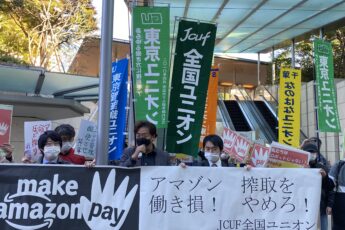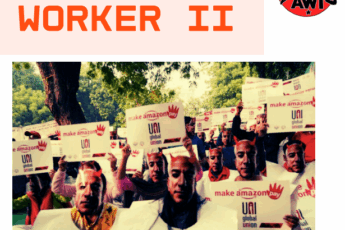
by INFOAUT (Italy)
We publish the English translation of a text written by the drivers who went on strike last week against Amazon in Pisa, Italy. For months Amazon, taking advantage of the pandemic, has been carrying out an increase in rhythms, hours and workloads for couriers throughout Italy and throughout the world, continuing to increase the number of daily deliveries required by the algorithm of the Amazon Flex app and to reduce staff with the redundancy fund, circumventing the block of layoffs. The growing work rhythms are causing an increase in the number of accidents and safety risks for workers, who find themselves compelled to make 170 deliveries in one shift. That means one delivery every 2 minutes and 40 seconds for 8 hours straight. Against all of this, last week the drivers of two contracting companies at the Pisa delivery station went on strike for four days, blocking deliveries, to collectively reject the working conditions imposed by Amazon. Like them, last week Amazon drivers in Brandizzo (Torino) and Fubine (Alessandria) went on strike, and like them drivers in Europe and the US are organizing to connect their struggles on a transnational level. We are on their side because the strike is our answer against exploitation: strike the giant!
Background
In November, during Black Friday, the new Amazon Delivery Station was inaugurated in Montacchiello (Pisa), with four contractors for the deliveries. In the autumn deliveries peak about 400 drivers worked. In December, the contracts of about 150 couriers were not renewed. Currently about 250 drivers work in this huge site. The year 2020 ends with fewer couriers and more deliveries. The year 2021 begins and deliveries do not decrease. On the contrary, Amazon decides to distribute the work in a different way but dividing it among the same number of drivers. An example: three drivers with 100 deliveries each, a total of 300 deliveries. From January 1, 2021, 150 deliveries are given to one driver, 150 to another and the third is no longer there, since his contract has not been renewed. So, the deliveries are given to the remaining drivers, 150 to 170 deliveries each. This leads to very heavy workloads and further consequences: stress loads, work under pressure – with managers inciting to “do it fast, do more”, accidents, fines, from speed cameras to parking. To Amazon, the driver must park in a smart way, too bad that in reality this corresponds to fines for parking, for parking in blue parking lots without having paid or put the disc time – the company does not provide it, for parking on the sidewalks. All actions that result in fines for those who work and urban stress for those who live in the city.
Drivers…
In recent months, the insubordination of those who work has begun … but on closer inspection the roots are deeper.
Who are these drivers?
They are people consumed by the rhythms of the so-called “platform work”. Young boys and girls who have been working as couriers for several years. Amazon has been in Pisa for about 4 years, but many of them also worked for classic couriers, such as BRT, SDA, TNT. Theirs is an ordinary life, before the pandemic they frequented the discos, the squares, they are students or former students, young mothers, couples with children, soccer fans, people who wanted to gain economic autonomy from their families.
How did they get worn out so early?
This job is to blame, since it forces you to chase algorithms, software, technological devices, looking for packages on the van, planning their layout, thinking about possible roads or routes. Running, always running. It’s a job that engages the mind when you’re driving the van but also when you’re at home, when you’re in bed and trying to get some sleep, when the phone rings with constant and assiduous communications from the managers: shifts to follow, van plates to learn, roads to know. The blockage and anger of these strikes is rooted in years of humiliation, suffering, loneliness.
The strike begins
About ten days ago, one of the contractors, Trasline, tells its drivers, three days before their monthly payment, that they have been placed on retroactive layoff (cassa integrazione). This means that the February paycheck, which regards January, will be lower (the layoff is paid at 80%). In addition, other money is missing from the paycheck: a regional supplement of about 57€ and the deductible (the compensation if the van is damaged, which should not exceed 250€ but this company is asking for 500€). These are the reasons why the strike lasted almost a week. On Saturday 27th the drivers of another contractor company, Loed, joined the strike. The strike started a few days ago but the tension and anger in the warehouse has been there for several months. They expressed themselves in outbursts, complaints in chat rooms or in the parking lots after the shift. It was always individual anger, and someone responding like this to a manager will definitely get a disciplinary letter. But when, together and organizing, you start a strike, it changes the symphony. You realize that your problem, the problem of struggling, of not being able to finish the route (the assigned delivery zone) is not only yours but everyone’s. Your condition is socialized: the route is reversed and a mindset is changed. In the strike and in the spontaneous blocking of the gates, the drivers, divided until that moment, become aware of their collective strength: “until we are heard, not even a single pack will leave the site! We are right!”
Negotiations
Negotiations between the confederal unions and the association that protects the interests of Amazon services (Assoespressi) have been ongoing for months. This is because Amazon is attempting, and in many cases has already succeeded, in derogating from certain points of the National Collective Labor Agreement (CCNL) for Logistics and Transport, to which the drivers belong. The main points of the bargaining that has been going on for months are: (1) Non-acceptance of article 42 of the National Collective Labor Contract, which stipulates the obligation for clients and subcontractors to integrate all employees under the same contractual conditions, maintaining their previous length of service, with equal pay and regulatory rights. (2) Increase in flexibility, that is, fixed-term and flexible workers hired through temporary agencies. This threshold is already not respected for the total workforce. (3) Smart companies 2.0: they are contracting companies where everything is for hire (their name is “staff leasing” – work for hire) and which are based on the suppression and humiliation of the rights of those who work and their introduction represents another departure from the CCNL.
This bargaining is not happening only in Pisa, but in many other cities in Italy: the modification of the CCNL is at stake, with clear deteriorations. In addition to the points listed above, there is also the reduction of compensation for illness, the extension of seasonality and on-call work, and the modification of the regulations regarding the right to strike.
During these days of strike action, negotiations with Assoespressi, the association of e-commerce contracting companies, also focused on reducing the pace of work. In the meeting held on March 1, Amazon and Assoespressi ignored every request from the workers. The confederal unions, accustomed to bargaining only to manage downward the conditions of workers, bounced against Amazon, that does not intend to give up one single millimeter of the exploitation that imposes on workers. The multinational company intends to further worsen the working conditions, and thus increase the suffering of tens of of thousands of people, and is not willing to accept any claim from workers: Amazon’s greatest fear is to build a precedent. To create it is the goal of those working in inhumane conditions, who also fights against the unions that have become the managers of the corporate order.
… and Amazon
“Amazon resets your brain, induces you to work breaking every physical limit of human capabilities. It makes you sustain inhuman speeds and rhythms that you would never have in life. They induce you to work this way: breaking the limits, of the road and of the body, and the very procedures they give you. Amazon tells us: you have to wait for the customer and for the package to be in their hands. But you can’t wait for the customer because otherwise you’ll never finish the delivery round, the route”. In the strike, a change in the mindset of drivers is happening. A liberation from the slavery of the algorithm and of artificial intelligence. One of the slogans of the strike is: “we are not an algorithm, we are not robots”.
Many workers went on strike despite expiring contracts, and despite their salary being the only source of income for themselves or their families. The strength of these strikes is the rise of a new mentality, which challenges the economic and psychological blackmail of the multinational company of the forced smile. There is the will and the need to set an example, to create communication with the other thousands of drivers. There is the awareness of the possible repercussions but also a stronger will to start to free ourselves, also because it is addressed to all the other people who work and suffer in other warehouses.
The aspiration of the strikers is not only to communicate the opening of a negotiation with Amazon to lower the number of deliveries. The aspiration is to start looking each other in the eyes, counting each other, saying “I strike” and being able to trust each other. We started, others will follow.





